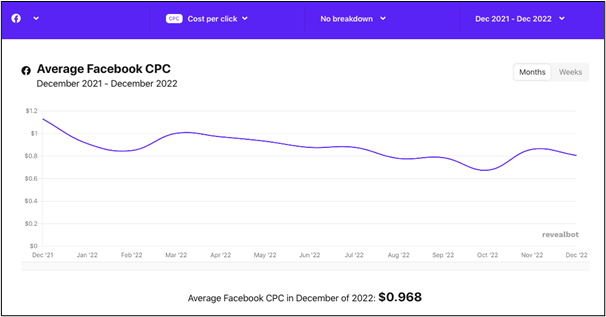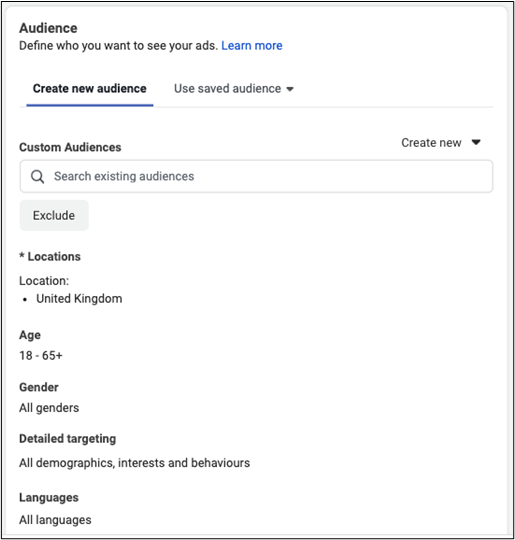Facebook Advertising Costs: How Much Can You Expect to Pay?
Key Takeaways
- US advertisers spent over $58 billion on Facebook ad campaigns in 2022, showcasing the platform's significant role in marketing strategies.
- Average costs for Facebook ads range around $0.97 per click (CPC) or $13.85 per 1,000 impressions (CPM), but actual expenses vary based on multiple factors such as industry, target audience, and campaign goals.
- Facebook's ad auction system determines which ads get displayed to users, emphasizing the importance of strategic bidding to optimize visibility and audience reach.
Facebook ad campaigns are now a staple of many marketing strategies, with US advertisers spending more than $58 billion on the platform in 2022 alone.
But if you’ve ever considered using this platform to advertise your business, you’ve also wondered about the costs.
In this post, we’ll walk you through everything you need to know about the costs of advertising on Facebook and discuss some tactics you can use to get the most from your ad spend.
Let’s dive in.
What is the Average Facebook Advertising Cost?
While there’s no definitive answer to how much the average Facebook ad costs, research suggests you can expect to pay $0.97 per click (CPC) or $13.85 per 1,000 impressions (CPM).

Keep in mind that these figures are just a reference. The amount you’ll pay for your Facebook ads will depend on a variety of factors, including seasonality, industry, ad placement, target market, campaign objectives, and bidding model.
Ultimately, of course, you’ll never spend more for an ad than what’s in your pre-set campaign budget. Facebook makes it easy to set a cap on your ad bids, as well as campaign and account spending limits.
How Does Bidding Work on Facebook?
Ad placements on Facebook aren’t limitless, so the platform determines which ads are shown to who via an ad auction.
Before entering the auction, you’ll have to set the relevant parameters for your ad. For example, you’ll need to specify your budget (per day or for the campaign as a whole), define your target audience, and design how you want the ad to look.
Unlike other ad auction models, Facebook doesn’t always give ad placements to the highest bidder. Since the platform tries to maximize value for its users and advertisers, it awards the placement to whichever ad has the highest value.
Facebook’s algorithm uses three main factors to determine ad value:
- The bid: How much the advertiser is willing to pay for the ad placement.
- Estimated action rates: How likely it is that the user will take the advertiser’s desired action when seeing the ad.
- The ad quality: Whether the ad lives up to Facebook’s quality standards.
Once the highest-value ad has been selected, Facebook will only charge the winner the minimum amount needed to win the bid. For example, suppose you set your maximum bid to $2.50, and the next highest bidder sets their maximum to $2.00. If you go on to win the bid, you will only have to pay $2.01 for the ad.
As a rule, the more advertisers compete for the same placement, the higher your ad costs will be.
What Is a Good Budget for a Facebook Ad Campaign?
The amount of budget you should set aside for Facebook ads will depend on your specific business objectives, other marketing activities, and industry standards.
That said, if you work at a small- to mid-sized business and want to test the waters before fully committing to Facebook ads, we recommend starting with a $5 to $10 daily budget for your first few campaigns. After a week or so, you’ll gather enough data to tell which ads perform the best. From there, you can start to ramp up your ad spend as you build more confidence in your strategy.
Over the long term, the level of investment you make into Facebook ads should depend on your expected return. Naturally, you’ll need to run a few campaigns before seeing what a realistic ROI looks like for you. In the next section, we’ll look at what you can do to stretch your budget further.
8 Ways to Reduce Your Facebook Ad Cost
Now that you’re clear on how the Facebook ad auction works and how much you can expect to pay, let’s see what you can do to make your ad spend go further.
Here are some tips to get a better return from your budget.
1. Create a Bid Cap
The simplest and most obvious way to keep your ad spend in check is to place a cap on your bids.
So if you don’t want to spend more than $2.00 per ad, set your maximum bid accordingly, and you’ll never overpay.
Keep in mind that this hands-on approach is more time-consuming than simply allowing Facebook to determine your bids algorithmically based on your campaign objectives.
Also, if your maximum bid is too low, you risk losing out on valuable ad placements, and Facebook may struggle to spend all your allocated budget.
2. Set a Strategic Campaign Objective
Selecting the correct campaign objective is essential for getting as much value as you can from your ad budget.
The Facebook ads manager lets you choose from six campaign objectives: awareness, traffic, engagement, leads, app promotion, and sales. The objective you select will determine the type of user who sees your ad.
To pick the right objective, you’ll need to define what outcome you want to achieve through your campaign. For example, if you run a relatively new business and want to create more brand awareness, you should select the ‘awareness’ objective. The ‘leads’ objective will be more appropriate if you want to collect leads via email sign-ups or messages.
Similarly, if you’re planning to reach more purchase-ready users, the ‘sales’ objective is your best bet.
Keep in mind that your average CPC will probably change depending on your objective.
Also, it’s important to realize that you can only select one objective per campaign. This ensures your ad’s imagery, copy, and target audience are fine-tuned toward fulfilling your goal. So if you want to pursue multiple objectives simultaneously, you’ll need to create separate campaigns for each one.
3. Target Specific Audience Segments
Since your campaigns can only focus on one objective at a time, they should only target one audience segment at a time.
Targeting your entire audience is inefficient because only a specific subset of them will be at the appropriate stage of the marketing funnel for any given campaign. For example, there’s no use in serving a brand awareness ad to a user who already follows you and has repeatedly bought from your business before.
Fortunately, Facebook lets you tailor your campaign audience to those users who are most likely to resonate with your ads.

The trick here is not to define your audience too broadly or narrowly. If you go too broad, you’ll target too many poorly-suited users and struggle to create relevant ads. And if you go too narrow, you’ll have trouble finding enough users who are willing to convert.
For this reason, it’s probably best to start with a slightly broader audience and experiment with narrowing it over time.
4. Keep Your Ads Fresh
Facebook provides a frequency score for each ad in your campaign, which corresponds to the average number of times each user sees your ad.
When users see the same ad too many times, so-called ‘ad fatigue’ can set in, and your campaign performance will drop. When this happens, it’s a good idea to refresh your ad with new copy or imagery to keep things interesting for your target audience.
As a rule, you should try to limit your ad frequency to below three. Any frequency higher than that probably means your ad isn’t resonating with your audience.
5. Make Your Ads Relevant
Users prefer ads that are relevant to their needs and interests, and relevant ads perform better for advertisers.
For this reason, Facebook places a significant emphasis on relevance when determining who to deliver a given ad to. Indeed, Facebook says relevant ads can often outcompete ads with higher bids in its auctions.
So what can you do to ensure your ads are relevant?
Facebook’s ad relevance diagnostics let you see how your ads have performed in the past across three metrics: quality, engagement rate, and conversion rate. These diagnostics tell you where your ads have fallen short so you can make future improvements.
For example, if your engagement rate is below average, you might need to design something more eye-catching. Or, if your conversion rate is low, you might need to rewrite your call-to-action (CTA).
To create more resonant ads, it’s generally a good idea to lean into your audience’s ambitions, interests, pain points, and tone of voice.
6. Conduct Retargeting Campaigns
Retargeting allows you to display Facebook ads to people who have already shown an interest in your business in the past. For example, they may have liked a few of your posts, signed up for your mailing list, or even bought something through your online store.
Unsurprisingly, retargeting ads tend to have a better ROI than normal ads. Since the target audience is already familiar with your product or services, they’ll often be willing to interact with you again.
To retarget website visitors, you’ll need to install the Facebook pixel. You can also upload customer data from your CRM to create a custom audience list.
7. Run A/B Tests
There’s no better way to develop increasingly effective ads at a lower cost than to regularly conduct split tests.
These mini-experiments pit two versions of the same ad against one another, displaying the first version to half your audience and the second to the other half. In doing so, they let you discover whether tweaking a particular variable has a positive effect on ad performance.
Facebook has an in-built A/B testing feature that lets you tinker with different elements of your ads, like headlines, CTAs, images, videos, placement, and so on. So be sure to try out different variations of your ads and monitor any changes that seem to improve performance.
8. Don’t Neglect the Post-Click Experience
Finally, to maximize the ROI of your Facebook ads, you need to make the post-click experience as seamless as possible.
If users are taken to a slow, clunky, and poorly designed website once they click on your ad, chances are they won’t convert. This is true no matter how attractive your ad campaign happens to be.
To improve the post-click experience, make sure that your page speeds are fast, your site is mobile friendly, and you direct users to personalized landing pages.
Is It Cheaper to Advertise on Google or Facebook?
Given the huge reach and granularity that Facebook advertising offers businesses, you may wonder whether it’s a better – and less expensive – alternative to Google Ads.
According to WordStream, the average CPC for Google ads back in 2016 was around $2.69 for search and $0.63 for display. No doubt these figures would be higher today, exceeding the $0.93 average CPC we see for Facebook ads.
But in any case, it’s a mistake to view paid search and paid social as opposing alternatives. Most advertisers can benefit from using both platforms together to maximize brand visibility and generate new leads and customers.
For example, let’s suppose your business sells sneakers. A user encounters one of your Facebook ads but isn’t quite ready to buy from you. Instead, they type your brand name into Google, click on your search ad, and check out your website and product catalog. They spend ten minutes viewing a particular pair of red sneakers and even click ‘Add to Cart’ just before leaving your site. A week later, you retarget the same user with a personalized Facebook ad, highlighting the red sneakers with a compelling CTA. Good news! The user is now convinced to reach for their wallet.
Final Thoughts
Facebook advertising is an extremely powerful tool, allowing businesses of all kinds to find specific audiences and serve them with hyper-targeted ads.
But to get the best return on your ad spend, you need to take full advantage of the platform’s various features and closely monitor how your campaigns perform.
Setting clear objectives, targeting the right audience, keeping your ads fresh and relevant, and split-testing your ads are all essential elements for getting the most bang for your buck.
Now it’s time for you to put all this advice into practice and start reaping the rewards of Facebook advertising. Happy bidding!
